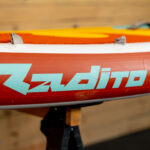Hala Gear Radito iSUP Review
Pros
- Flatter midsection Improves stability and control for newer paddlers but still handles waves and drops well
- High quality construction and materials for reliable use on whitewater year after year
- StompBox fin system allows you to use a larger fin that retracts into the board on impact
- Highly versatile design for rivers Class I-IV
- 5-year warranty and excellent customer service
Cons
- Does not come with a paddle, however Hala’s paddles are great for use on the river
- Not enough room for self-support multi-day expeditions, but just enough room for a quick overnight trip
Hala’s Radito whitewater SUP offers versatility, utility, and capability for whitewater paddlers of all skill levels
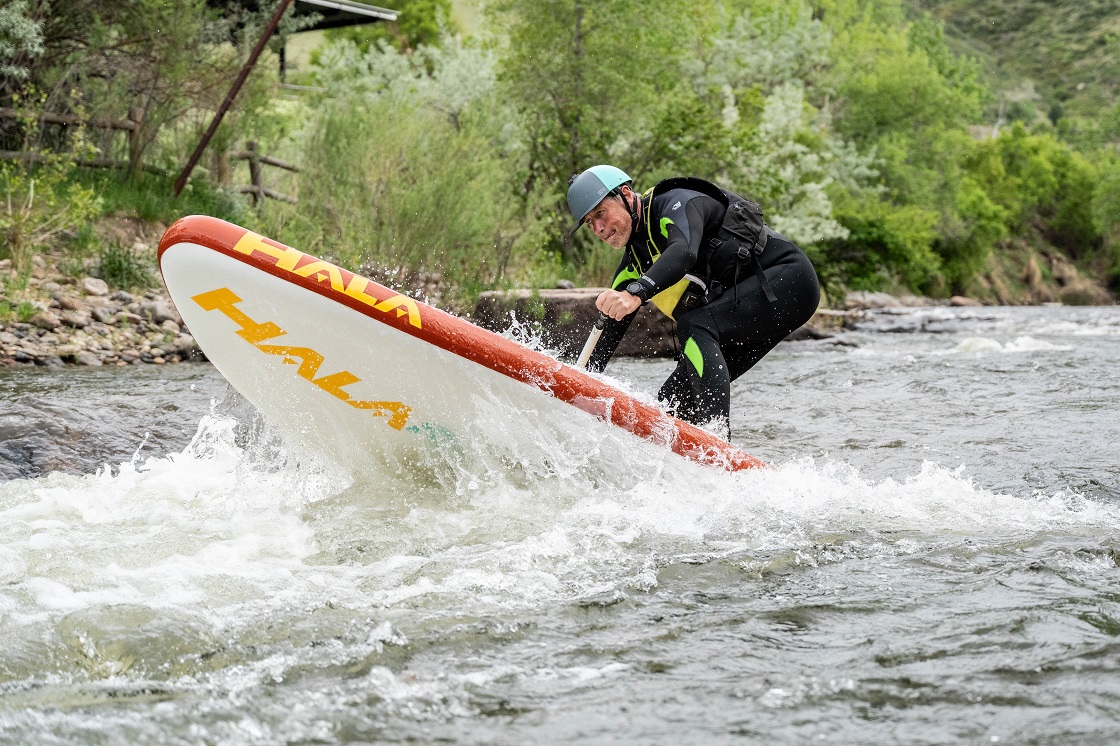
I remember, many years ago, testing out a Hala Radito iSUP at the Oklahoma City Whitewater Park (yes, it sounds weird to see “Oklahoma” and “Whitewater” in the same sentence but it is absolutely awesome). I’ll be honest, I got chewed up by the whitewater park, but it was my first season whitewater SUPing and that place is no joke! With the Atcha 96 being so revered for its whitewater performance (and close in size) I wasn’t really sure what the Radito was for back then.
Getting back out on the river with the Radito now has been awesome, and I completely understand why Hala makes this board.
If you’ve ever paddled whitewater rivers from a SUP, kayak, raft, or any other vessel, you know that it’s not 100% big rapids. In fact, most whitewater runs are mostly flat with bits of excitement sprinkled in. If you’ve ever paddled a high-performance whitewater SUP like the Atcha 96, you know they are built specifically for those biggest, hardest sections of the river, but can sometimes struggle elsewhere, especially for newer river paddlers – and forget loading them up for long-distance trips!
The Hala Radito is that wonderful blend of action-ready design with the size and shape that helps make those flat sections feel shorter and lets you bring more than just a water bottle down the river.
Since I’ve already reviewed the Hala Radito from my perspective as an experienced whitewater SUP paddler and instructor at InflatableBoarder.com, I brought SUPBoardGuide writer Bill Dawes along with me to the Clear Creek Whitewater Park in Golden Colorado to get his perspective on the Hala Radito. Bill is a very experienced paddleboarder and SUP surfer, but has very little experience on whitewater.
We think the Hala Radito would be a great SUP for:
- Beginner whitewater paddlers looking for a forgiving board that will grow with them into and through Class III rivers
- Intermediate and Advanced paddlers who want a whitewater board that is nimble and playful, but can carry everything you need for a long day or light-and-fast overnight trip
Hala Radito: Spec Sheet
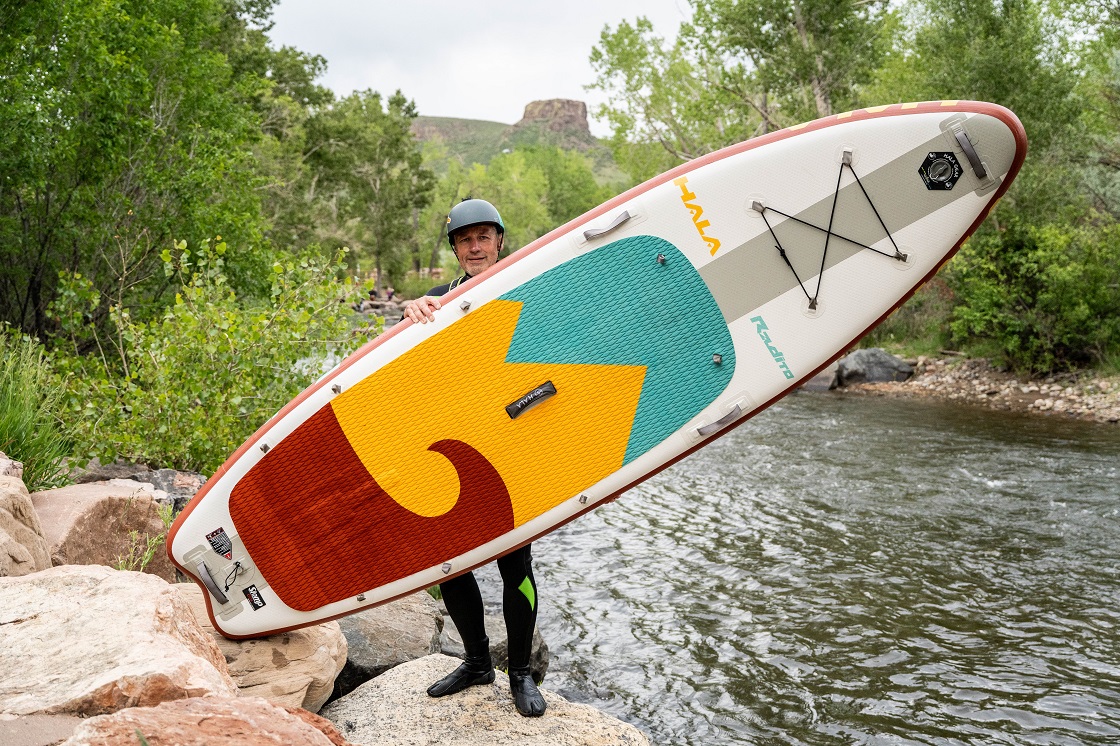
- Board Categories: Whitewater / Rivers Class II+
- Listed Board Dimensions: 10’0” x 34 x 6”
- Measured Board Dimensions: 10’0” x 34.5” x 6 “
- Listed Board Weight: 26.5 lbs
- Actual Board Weight (board + finbox, inflated): 26.3 lbs
- Listed recommended Capacity: 300 lbs
- Listed max capacity: None
- Recommended PSI: 18 psi
- Fins: Retractable flexi 9” dolphin center fin, plus 2 side fins.
- Paddle: Optional
- Board Shell Construction Materials: Double layer fusion, with welded rails
- Drop-stitch type: Woven
- Price Range: High
- Warranty: 30-day refund (unused), 5-year full warranty
Performance Review of the Hala Radito Stand Up Paddle Board
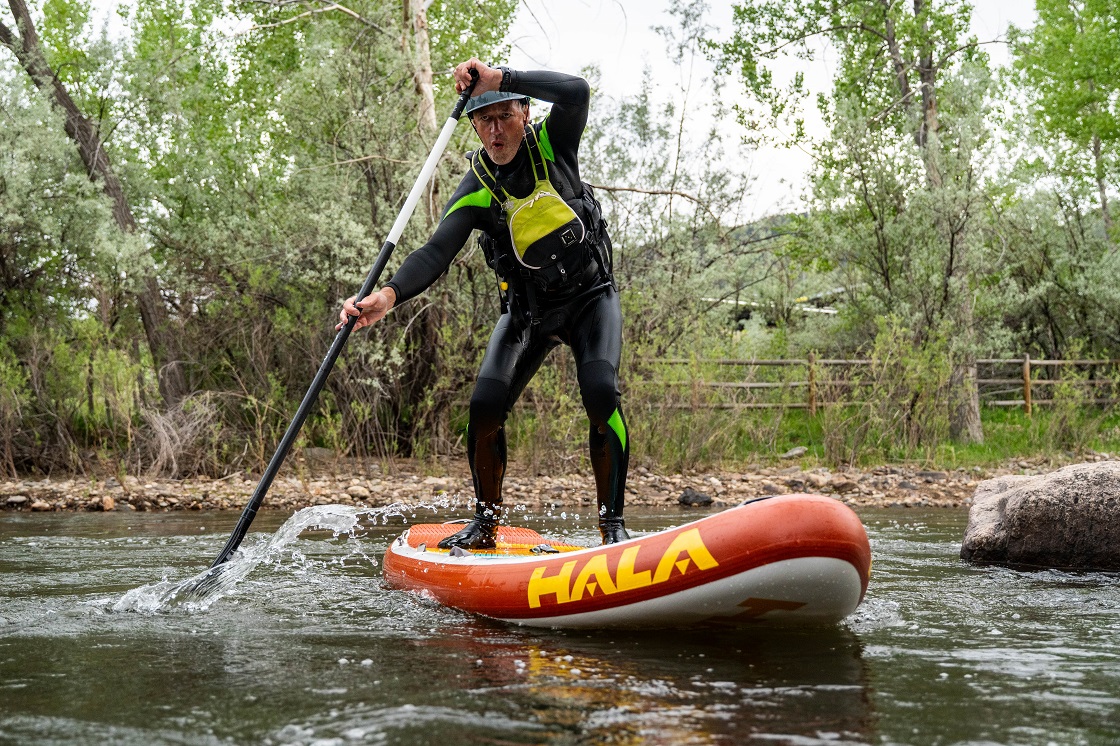
Overall Score: [9.7/10]
- Stability: 9.8/10
- Speed & Attaining: 9.7/10
- Agility: 9.7
- Waves & Drops: 9.7/10
- Construction Quality: 9.5/10
- Features/Accessories: 9.4/10
Since the Hala Radito is a highly specialized paddleboard, we’ve adjusted our rating system to reflect its intended purpose rather than trying to squeeze it into our framework for reviewing all-around and other flatwater-designed boards.
Stability Rating: [9.8/10]
The stability score shown here is based on comparative performance to other whitewater paddleboards, rather than all paddleboards we’ve reviewed.
Stability on a whitewater SUP is a little different from stability on a flatwater paddle board. Whitewater SUPs are made for agility, handling large river features, and excellent secondary stability (on their edge) rather than maximizing their stability while totally flat. While a performance whitewater SUP may feel less stable than a flatwater SUP of the same width when sitting flat on the surface, they make up for it in their stability when paddling over fast, changing current and features like waves and holes.
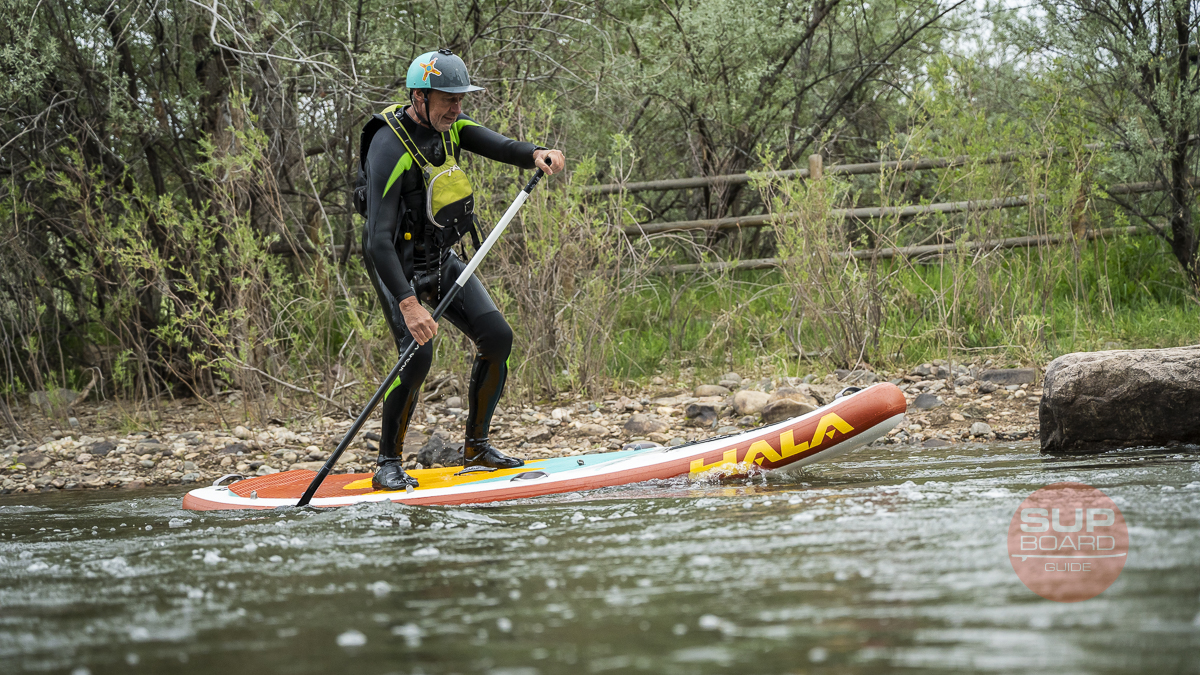
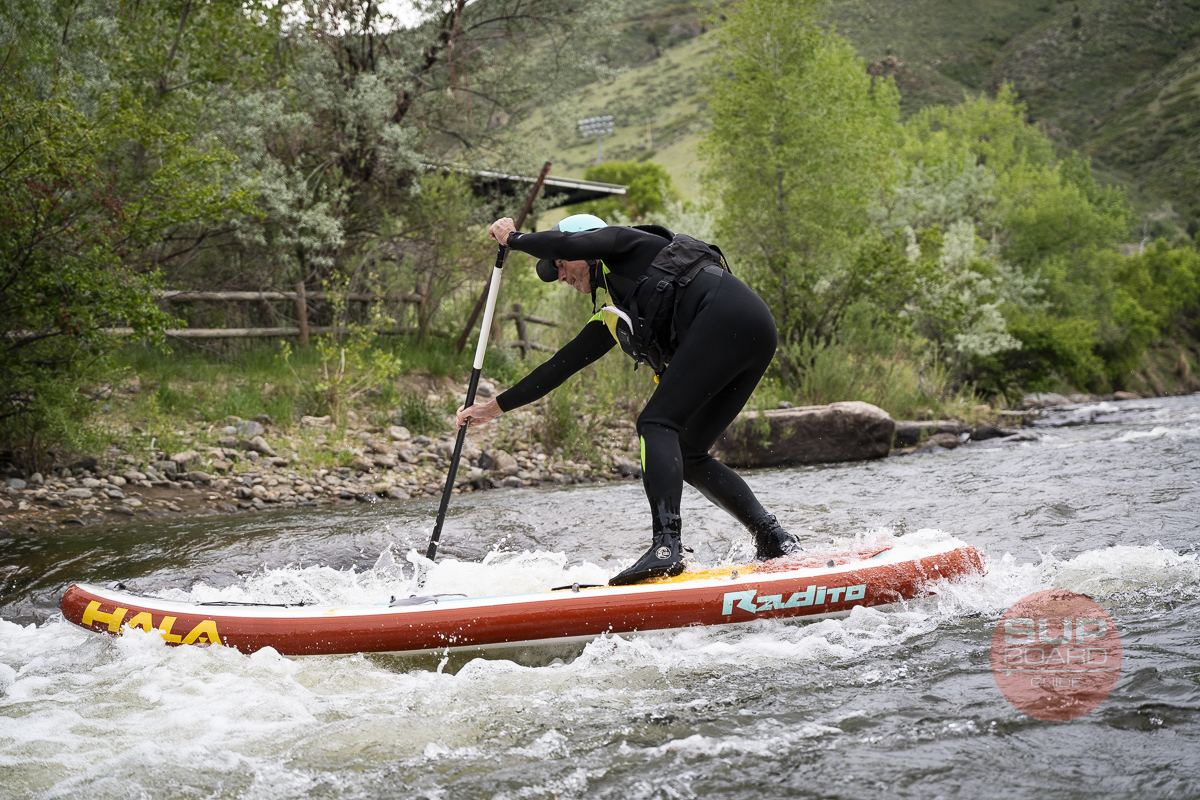
I wouldn’t go as far as to say the Radito is a crossover board between flatwater and whitewater – it’s definitely a river board – Hala reduced the nose and tail rocker of the Radito compared to the Atcha 96, and kept a larger section of the middle of the board flat.
In practice, this means that even though the Radito is a full inch narrower than the Atcha 96 (34.5” vs 35.5” as measured), the Radito actually feels more stable through most conditions. Once you start getting into significantly larger wave trains, holes, and drops, then the Atcha’s specially-designed shape really takes over and feels better going through those features. But for beginner through intermediate paddlers, like Bill, the Radito does offer more primary stability.
Bill really noticed this right away, handling his first few waves on the Radito much easier than his time on the Atcha 96. In particular, Bill felt more comfortable leaning and relying on the rails of the board. The longer midsection helps improve the overall surface area in contact with the water, especially when tilted on edge. This helped Bill stay upright more often and made ferrying across the current easier as well.
Speed & Attaining: 9.7/10
The score given above is a comparative rating to other whitewater paddleboards, but not in comparison to other types of SUPs.
Speed on a whitewater paddleboard is a different feature than speed on a flatwater board, especially if you are looking at touring or racing style SUPs. However, speed and efficiency are important for a whitewater board. You still need to be able to accelerate quickly and even paddle upstream from time to time.
Paddling speed
The Radito’s flatter profile gives it a longer waterline length. That helps improve both its overall maximum speed and its efficiency. On the water Bill easily adjusted his speed (up and down) while paddling on “flat”water and through the not-so-flat sections. He found it to accelerate quickly when he wanted it to, and it also stayed on course a little better with each paddle stroke than the more rockered Atcha 96. While not as fast as his racing boards, Bill found the Radito to feel lively on the water and never felt like he was pushing it through anywhere. The high rocker profile and pointed nose also helps carry speed through waves and holes, even if the board does dip down and pearl a bit first.
Attaining Up River
Paddling up river can be a great workout, but it’s also an important skill as you progress in whitewater paddling. While the whitewater park doesn’t have any “must make” moves, wild rivers often do and can be the difference between passing safely and easily through a rapid or being in for an absolute wild ride (and not in the good way)! Moving back up the river allows you to reposition safely to line up for your run.
The Radito’s lowered profile and slightly narrower outline helps keep it aligned where you want it and gives you a little more speed and efficiency compared to the Atcha 96, and makes it one of the better attaining whitewater boards we’ve tested. Even in faster current, the Radito holds its line and speed better than more aggressive whitewater boards, but still handles the waves and chop with ease.
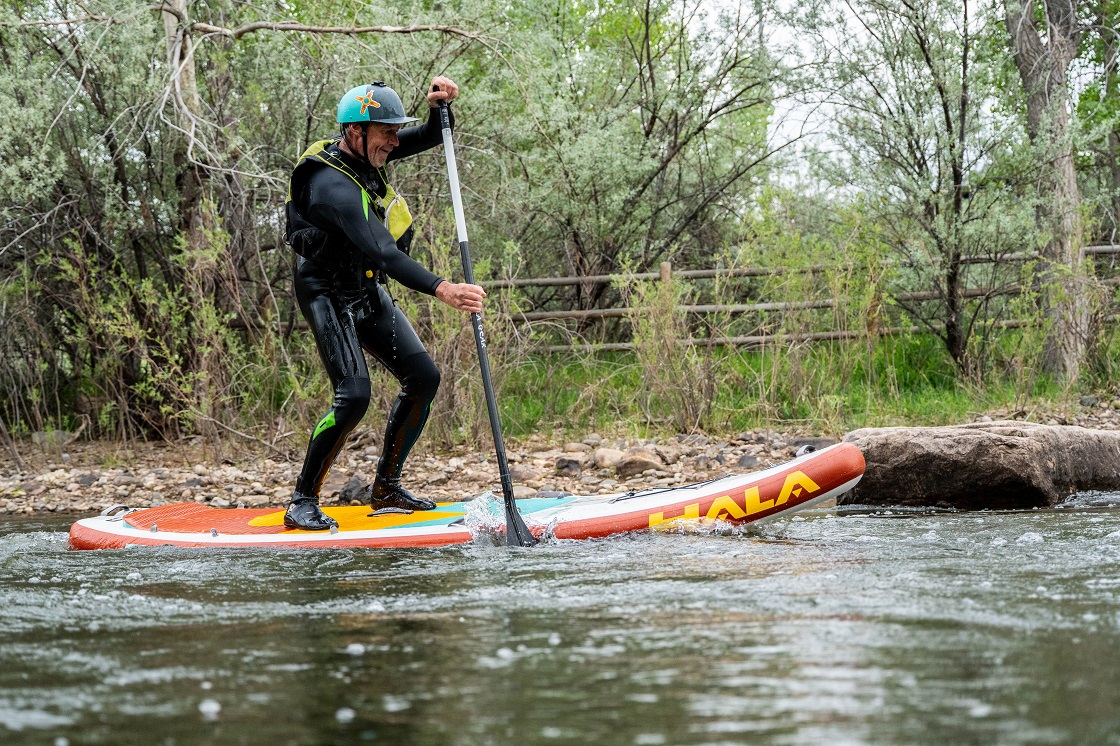
Overall
The Radito is a fast whitewater SUP. It’s versatile shape and profile along with it’s great tracking ability, make it easy to move quickly up or downriver. It also makes it a great choice for whitewater SUP racing in those Class III(-) environments where you don’t need the most aggressive rocker profile, but doe want better paddling efficiency.
Agility: 9.7/10
Making tight maneuvers and controlled river crossings is a critical skill for any whitewater paddler and can be greatly impacted by board and fin design.
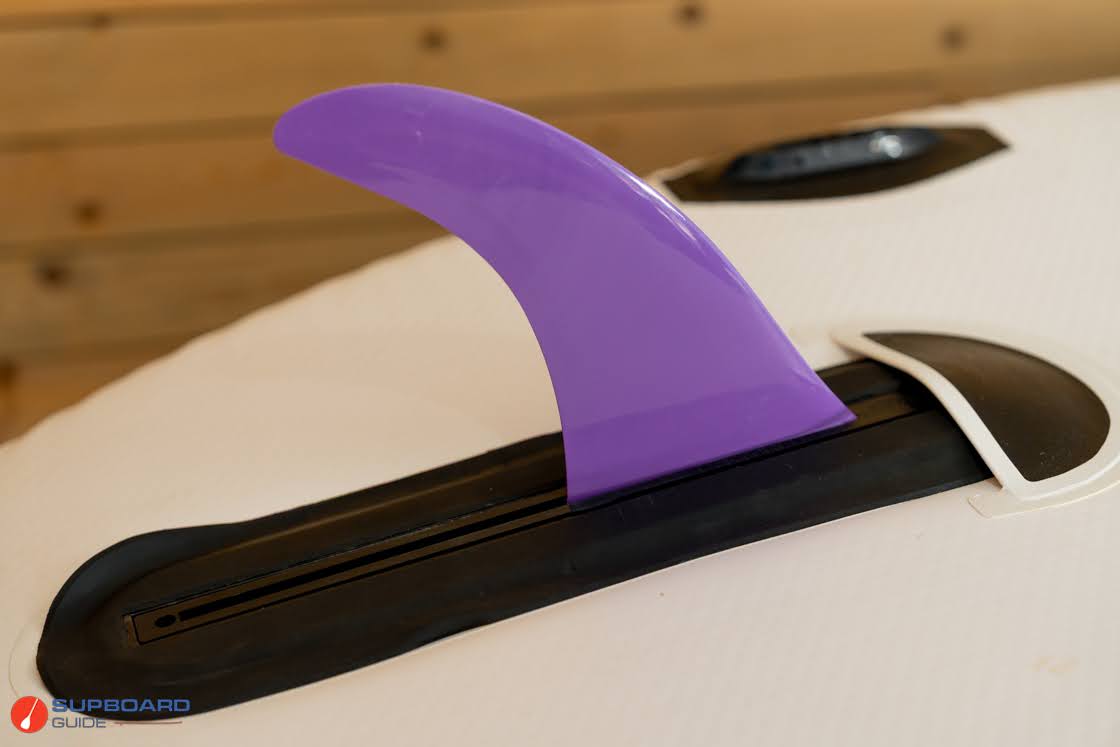
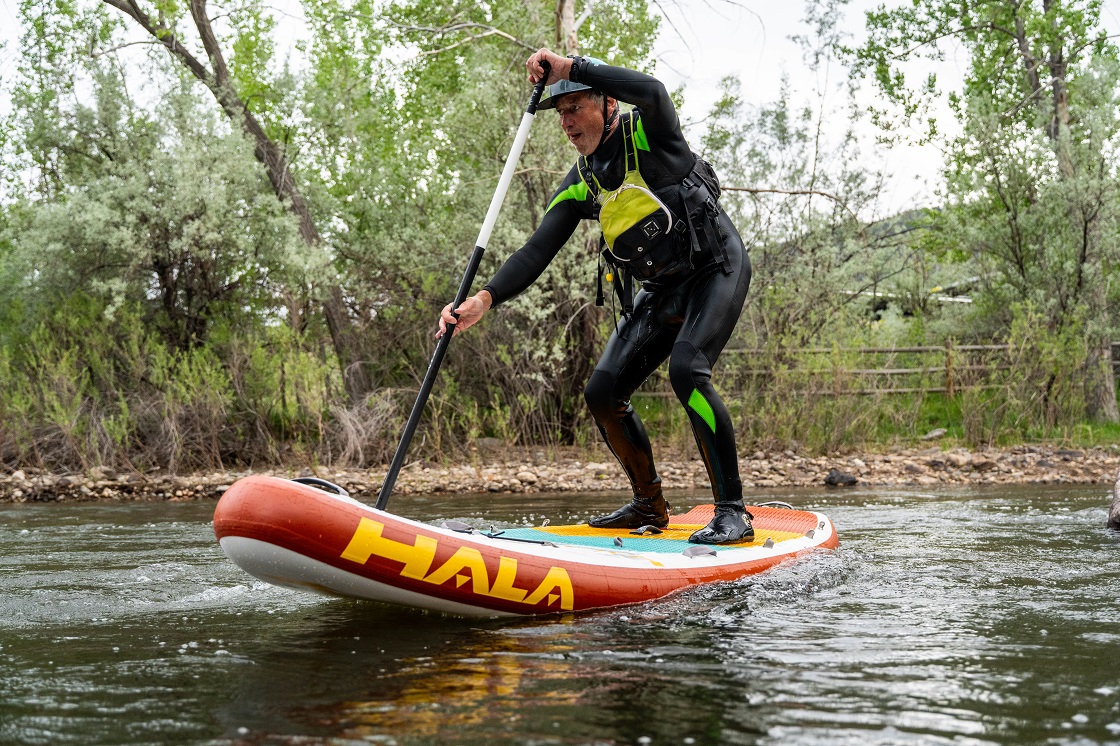
Turning
As an experienced SUP Surfer, Bill is used to advanced maneuvers to quickly turn a smaller board, so he felt right at home moving the Radito around on the water with quick sweeps and cross-bow draws. It’s not as agile as the Atcha 96, but if you weren’t comparing the back to back like Bill and I were, you may not notice, especially if you are a newer whitewater paddler.
Neither Bill nor I had any issues steering the Radito where we wanted it to go and keeping it on course once we got there. Adjusting our position toward the tail helps make the board even faster to turn, while shifting weight forward onto the middle of the board helps lock it on course
Ferrying
Ferrying is an important skill that, like attaining upstream, allows you to adjust your position on the river, but without moving downstream or upstream. By pointing upstream at the right angle and adjusting the tilt of your board, you can slide across the river with just a few paddle strokes to keep you moving.
The Radito’s longer waterline and the 9” StomBox fin system help keep the board moving the right way with minimal input. Every now and then the 9” fin did a little too good and spun the board more directly into the current than we wanted to go, but the longer waterline of the Radito helped keep that in check better than the high-rocker of the Atcha 96.
Overall
The Hala Radito is a high agile board when you want it to be, but can also lock on course easier than a more advanced design like the Atcha 96. It’s a great balance between agility and tracking performance that I really appreciate, especially when working with newer paddlers who may not have the same level of overall board control that Bill does.
Waves & Drops: 9.7/10
You can’t have whitewater without gravity! How well a SUP handles sudden changes in elevation (both down and up) is vital for whitewater performance.
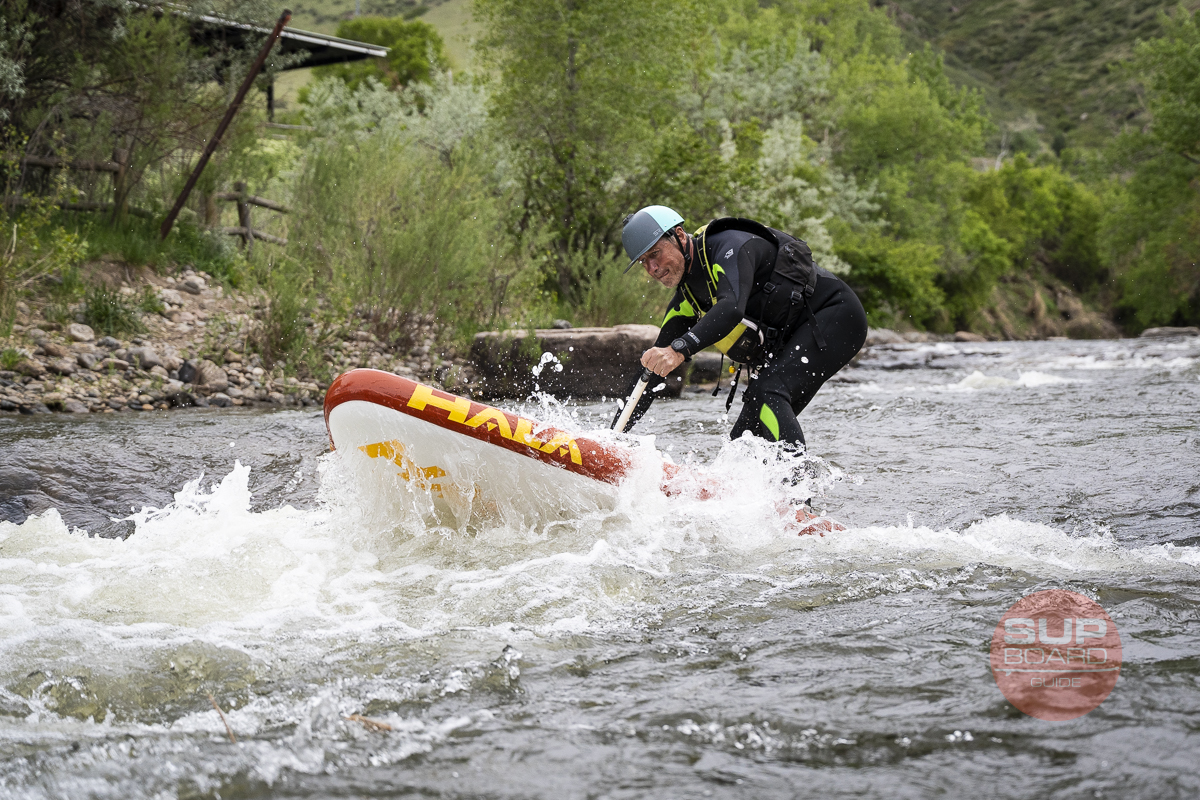
The Radito is all about balance between handling anything the river can throw at you, but still being capable on flat sections and for longer days when you need to move faster down the river.
The continuous rocker profile is a little lower than the Atcha 96 to help accomplish this. However, neither Bill nor I found it to be an issue at all while working through the Class II whitewater park and can see it easily handling the larger drops, waves and holes found on Class III rivers. The pointed nose does help the Radito break through any features that it can’t quite climb over, and it resurfaces smoothly without getting caught in the foam pile.
Because it is a little narrower, it doesn’t offer quite as much instant stability through the waves as the wider Atcha 96, but I often found myself forgetting that it is “just” 34.5” wide. We both found the Radito to offer plenty of stability and capability while moving through the various features at the Clear Creek Whitewater park.
Construction Quality: 9.5/10

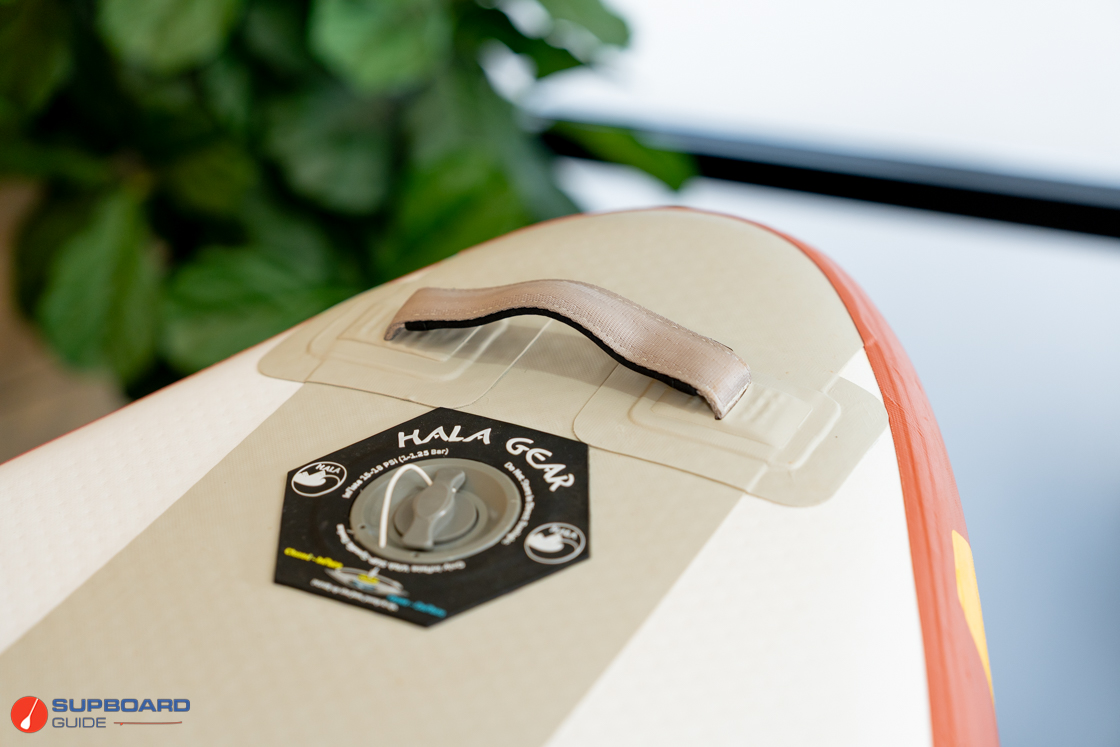
Hala has always been focused on building their boards with the highest quality materials designed for the job. By combining both time-tested materials and new technology, Hala has made the Radito a durable and effective whitewater board.
Inside the board
The drop stitch core uses a woven fabric base layer, but rather than opting for the ultralight cross-woven stitching, Hala uses a traditional V-stitching. It’s still extremely rigid and the slightly higher weight helps maintain your momentum while paddling through whitewater.
Top and Bottom Skin
The outer skin is a dual-layer fusion PVC laminate for greater rigidity and durability to combat river rash and the other hazards of whitewater paddling. They also install a wide PVC stringer on the deck to help stiffen the board further.
Rail construction
Hala heat-welds their rails for maximum durability and longevity. This process involves both a chemical glue and a mechanical bonding process for the inner rail. The outer rail layer is more reinforced PVC that wraps around the entire board and covers the top and bottom rail connections for even more protection.
Overall
The Radito is a few pounds heavier than other whitewater SUPs in its size range, but that extra weight lends it both rigidity and momentum when paddling on the river. It also feels like a heavier-duty paddle board, and we’ve bounced it off plenty of rocks to make sure that it is!
Board Stiffness: 1.34 ” bend (Radito)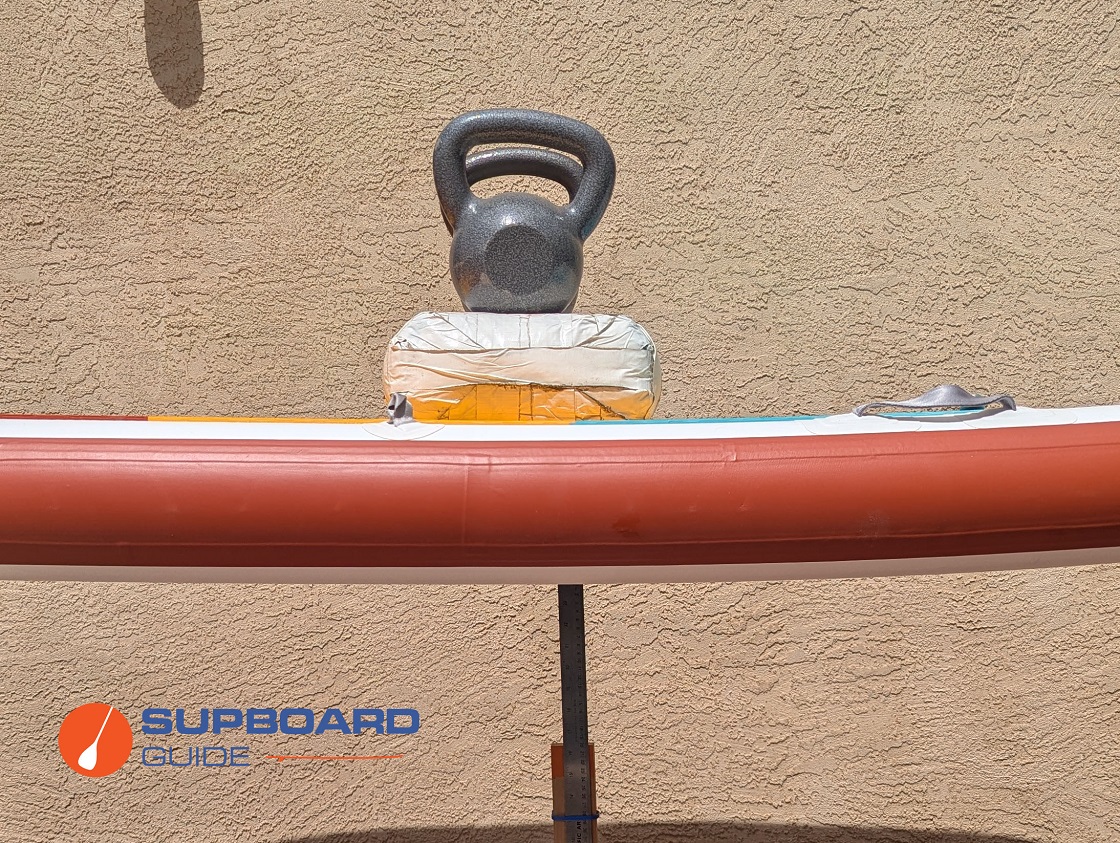
The Radito bent 1.34” in our deflection test with 150 pounds of weight. While the image above looks like it is bending significantly more, that is just because of the continuous rocker profile that gives the board its high agility and whitewater capability on the water.
While it has a little more bend than the Atcha 96, neither of us felt any flex while actually using the Radito on the water. Standing, walking, paddling, paddling over waves and drops, and even falling on the board – it felt pleasantly solid the whole time.
To ascertain the rigidity of each board we review, we use our own specific laboratory bend test process. The board is inflated to its maximum recommended PSI and then placed across two sawhorses positioned exactly 7 feet apart. We then measure the distance from the middle of the board to the floor. Then, we place a 150 lb weight on the middle top of the SUP, and measure the distance to the floor again. The difference between the two measurements shows the deflection, or ‘sag’, that the board has experienced due to the added weight. We have been reviewing the stiffness of boards using this technique since 2021 and while it isn’t an exact replication of the weight distortion that occurs when a rider stands on a SUP board in the water, it still gives a very useful comparative tool in determining the stiffness of the board’s construction process.
Features/Accessory Review: [9.4/10]
Features:

The Radito’s colorful deck pad is made with a high density EVA foam with a diamond-groove pattern for excellent traction. The mountain and river motif are made from separate die-cut sections and cover the most used portions of the board well.
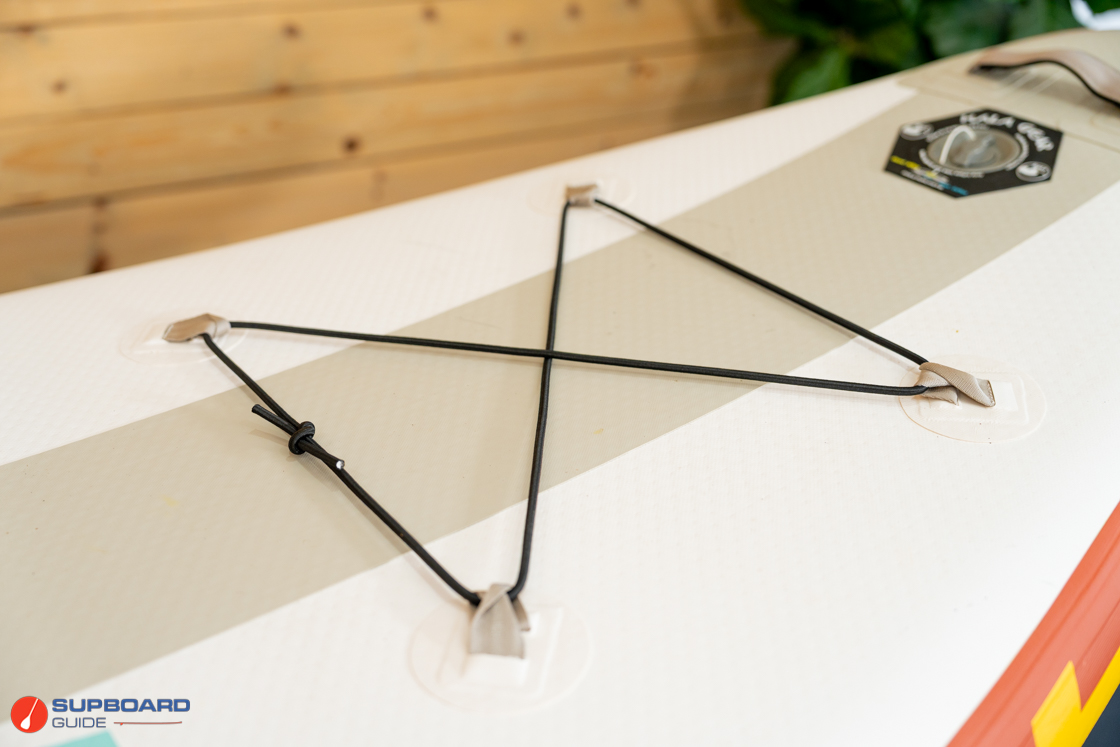
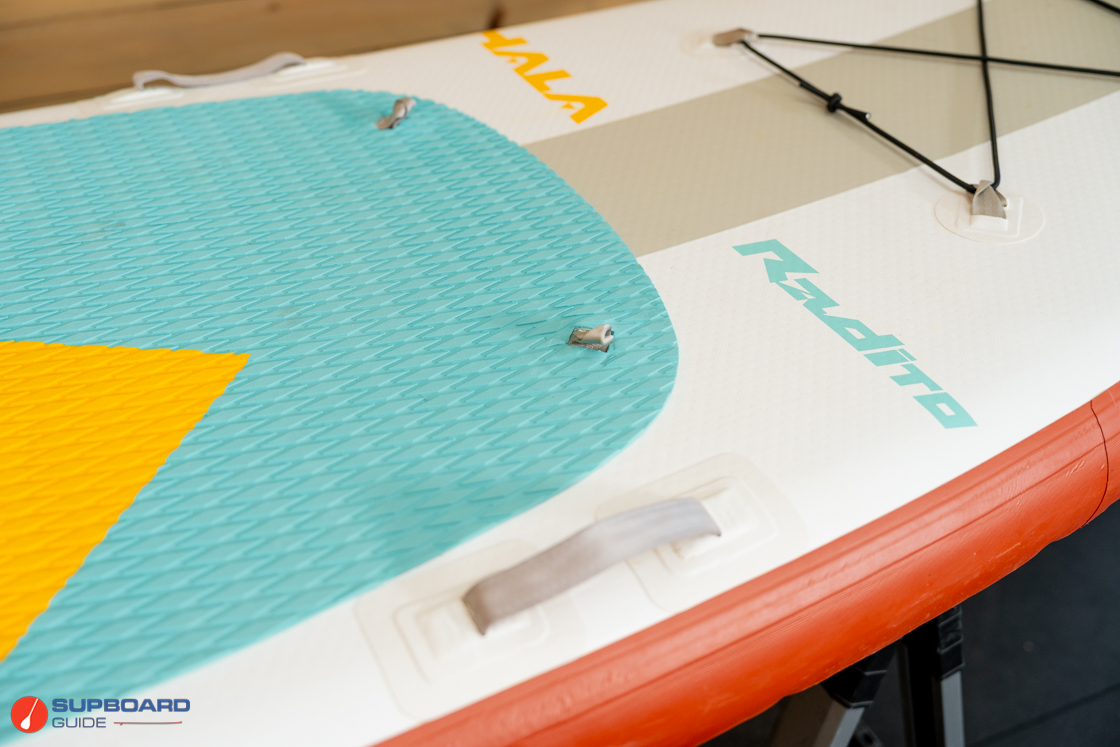
The front cargo area is made with a standard bungee cord rigged between four nylon loops. Hala uses these soft rigging points for safety reasons. Metal D-rings can be painful to fall on, but they can also potentially trap a finger or more easily hook on to a carabiner that was left unlocked. These are just some of the small touches that Hala has put into their gear that don’t seem like much on the surface, but come from years of experience on the water. While those instances don’t happen often, they can be very bad when they do.
There are also two grab handles located at the front of the standing area (in addition to the center, nose, and tail carry handles). These are great for holding on to your board while kneeling if things get a little too rough and for controlling the board on the water if you do go for a little swim.
Because the Radito is built for adventure trips (longer distances, short overnights, etc) Hala added three more pairs of rigging points through the middle and rear of the board. These let you easily and securely strap down larger dry bags for your camping and other equipment.
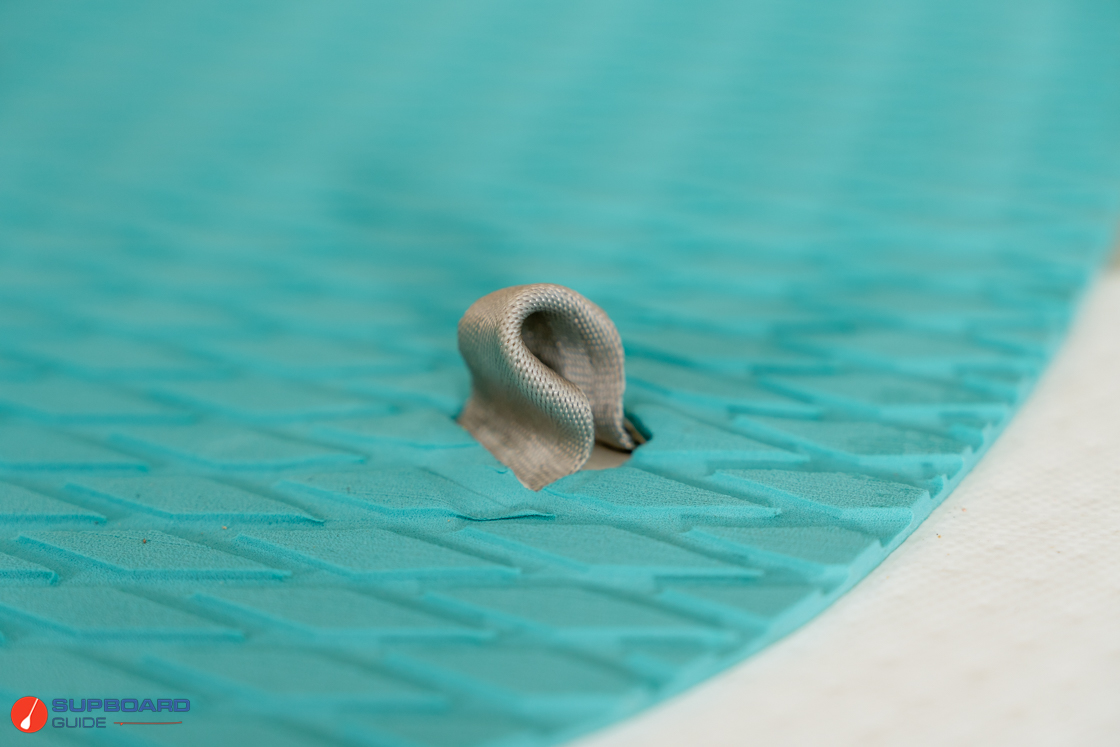
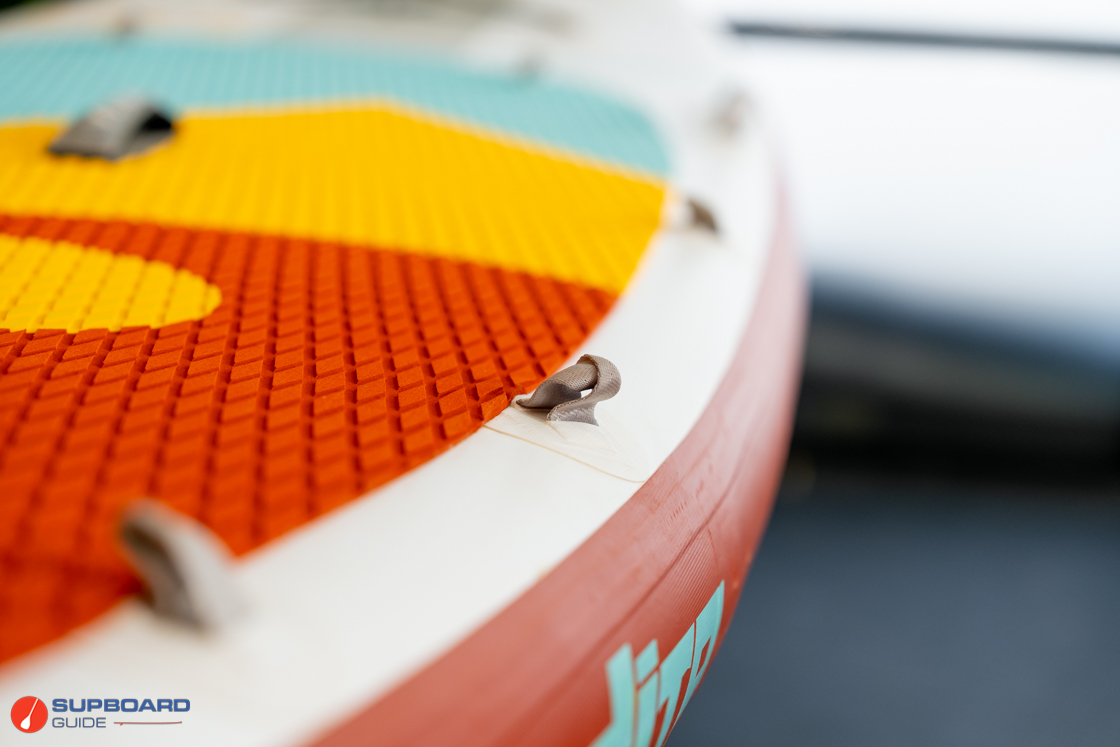
Toward the tail of the board, there is a set of raised pads under the deck pad. These indexing pads give you tactile feedback for the position of your feet when changing positions or stances while paddling. They help you find the midline of the board for better balance, and let you know that you are getting closer to the end of the board.
At the back end of the pad, there is a 1.5” raised kick pad to create a positive stopping point for your foot position and improve control when lifting the front of the board out of the water for surfing or pivot turns.
The very tail of the board ends with a reinforced D-ring for your leash (if you are using a quick release leash system – otherwise don’t use a leash on the river!) as well as a carrying handle. The inflation valve is at the nose of the board to make more room for the deck pad at the tail and make deflation and rolling easier at the end of the day.
The slight fish tail shape at the back of the board helps improve maneuverability when surfing and sinking the tail, but keeps the back end much wider than a pin tail or rounded tail shape for better stability.
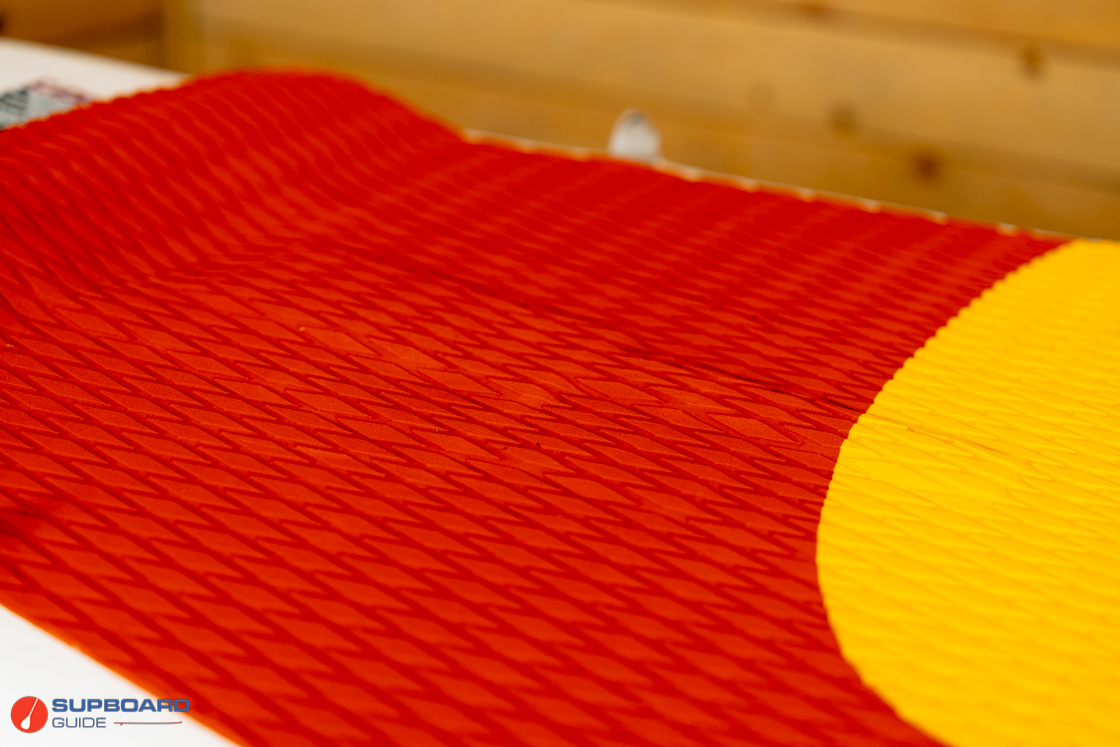

Under the Radito there are two FCS Two-Tab fin boxes and a hollow section in the board to fit the patented StompBox fin system. Hala includes two 4.5” gummy fins for the side fin boxes, though they are compatible with hundreds of other FCS Two-Tab fins if you wish to use something else.
The StompBox fin system uses a separate plastic insert that contains a spring loaded system and the included 9” surf-style fin pre-installed. Before the board begins to pressurize during inflation, simply insert the StompBox fin system into the hollow section of the Radito, and a set of hard foam blocks and the pressure of the inflated board keep it securely in place. This allows the 9” fin to pivot and fold up into the board if it hits something under the water, and the spring pushes it back out after you’ve moved into deeper water.
Like the Hala Atcha 96, I do think the Radito would benefit from both a towing D-ring on the nose of the board and a GoPro or threaded accessory mount on the nose for capturing all the fun you’ll have on the river while riding the Radito.
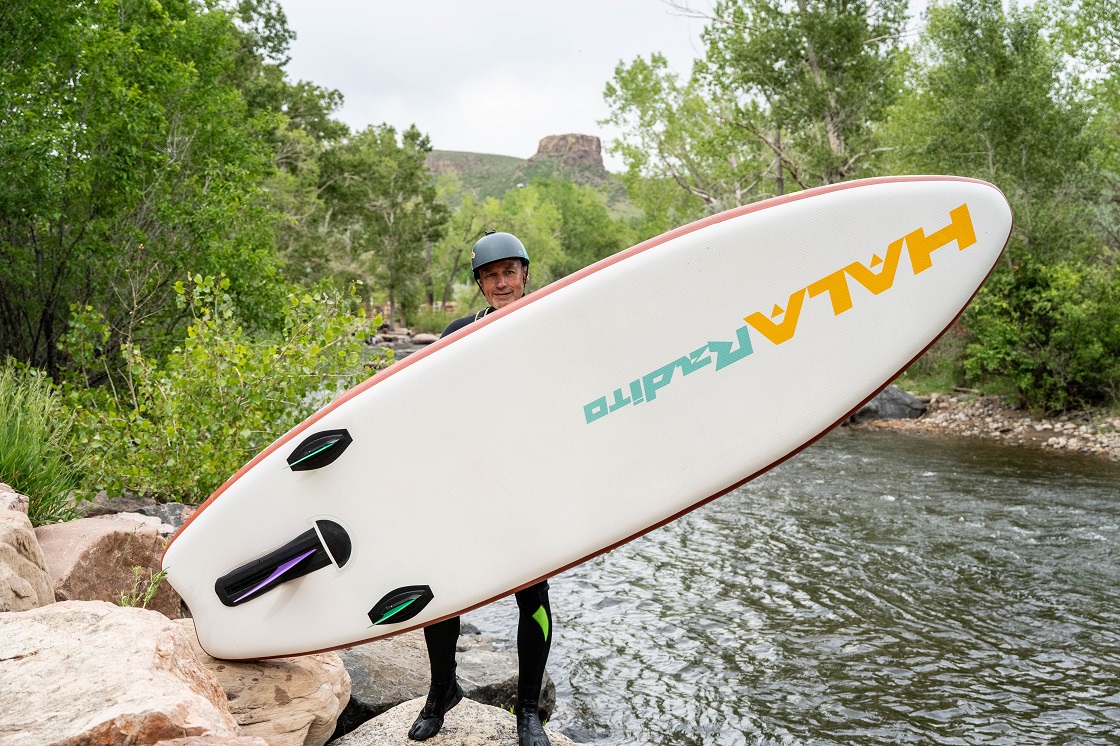
Included Accessories:
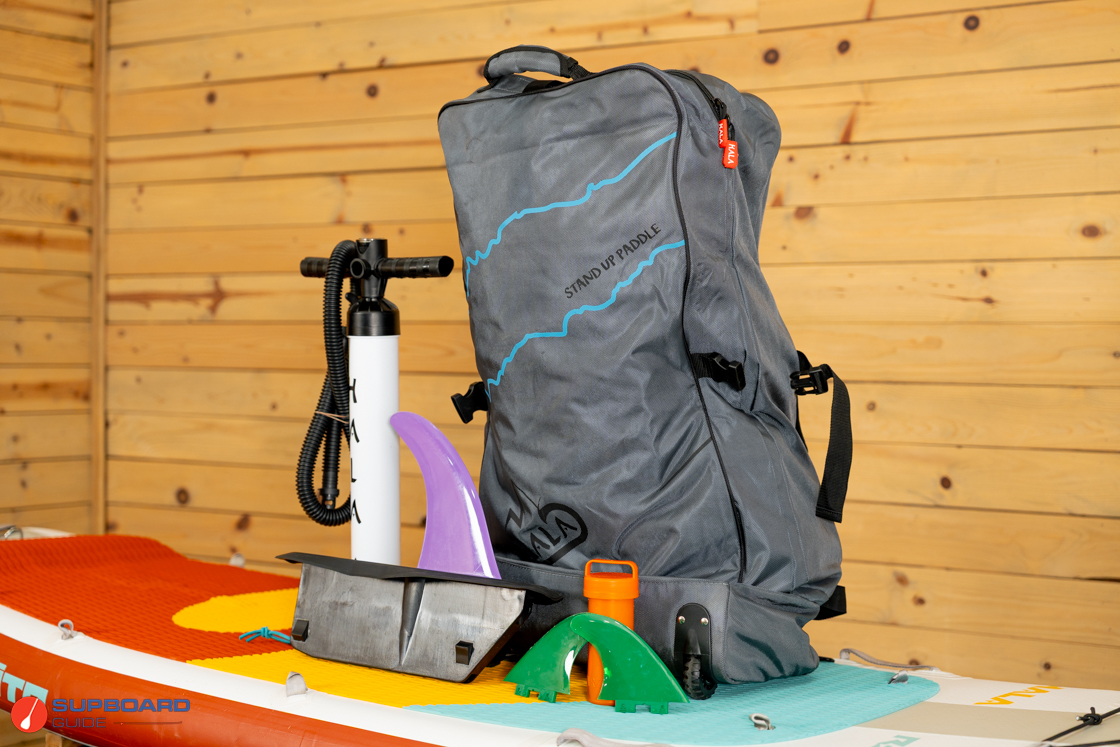
The Radito comes with a basic set of accessories to get you on the water, however you will need to add a paddle if you don’t have one already. Along with the Radito, you get a wheeled SUP backpack, double-action hand pump, StompBox fin system with 9” flex fin, two 4.5” FCS compatible fins, and a basic repair kit.
Hala does not include a paddle with the Radito6, nor do they offer their paddle at a discount when bundled with the board. While this would be a negative for a typical flatwater board, I don’t see this as a problem with a whitewater SUP. Most paddlers purchasing a whitewater SUP will already have a paddle they like. If not, Hala’s Grafik paddles are made for the river with a large 7-layer composite blade and carbon fiber shaft for durability and rigidity.
Summary Review of the Radito Whitewater SUP

The Hala Radito is one of the most versatile whitewater SUPs on the market. It’s quick, it’s agile, it tracks well, it’s stable, and it handles whitewater like a champ. It’s not as aggressive as the Atcha 96, so if you are regularly hitting those Class IV+ rivers, you may want to head over to that review. But whether you are just starting out with your first whitewater lessons, or a seasoned pro who wants an adventure-ready SUP that doesn’t compromise on performance, the Radito is a great choice.
Bill really enjoyed how beginner friendly the primary stability of the Radito was compared to the stable-but-different feel of the Atcha 96. We both agreed that the Radito is the exact kind of board anyone who is just getting started in whitewater SUP can buy with confidence to have the comfort to get going and the growth potential to take you onward to big adventure and excitement as you progress in skill.
If you have any questions or comments please let us know below!
SupBoardGuide
Latest posts by SupBoardGuide (see all)
- Best Kids Paddle Boards (SUPs) – 2025 - November 11, 2025
- Best Stand Up Paddle Board for Fishing – 2025 - November 11, 2025
- Best Yoga SUPs of 2025 - November 11, 2025


